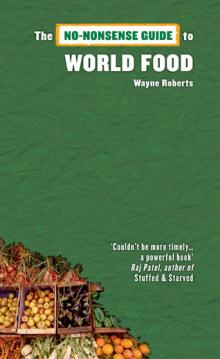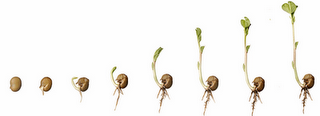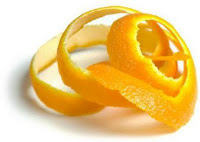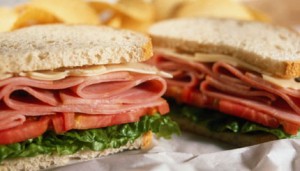I finally finished the biggest little book I’ve read in a while: Wayne Roberts’ The No-Nonsense Guide to World Food, 2008. (merci François!)
World food is clearly a vast topic, but Roberts is a man for the task and walks us though the whys and wherefores of our current global food systems, and more importantly, how we got to be here.
Pulling from various sources, sector experts and personal experiences that have taken him around the world, Roberts uses simple, direct language that will appeal to those hungry to learn more about the reality of our global food situation.
Roberts begins by explaining how a food system, is exactly that, a system. And as a systemic entity (think respiratory, circulatory), it reaches far into all aspects our lives, and our communities. Family meal times, recipes handed-down over generations, seasonal celebrations and cultural festivals all tie us back to the food we eat – and to the land where we live. But the post-war modernist approach to food production, which industrialized agriculture and turned food into a commodity, drew us away from this connectedness, and has managed to pit Global North against Global South. And we are all poorer for it.
This book will give you ideas of how to get your food system back.
As David Suzuki writes on the inside cover page, “Books like this get us started in our thinking and our actions.”
Spring is here! And the Seedy Saturday (and Sunday) Seed Exchanges throughout Canada are going fast. (I have a new garden to play with this year, so I’m rather excited.)
I haven’t managed to make it to one of these exchanges, where you can buy heirloom and rare seeds for your garden (or balcony), BUT the next two exchanges in my area are entered in my phone. Really.
For dates in your area, see the Seeds of Diversity site.
If there isn’t a seed exchange near you, here are some worthy-of-your-$ seed suppliers that also do good work to preserve seed heritage:
Seeds of Diversity Resource List 2012
If you’re in Toronto, Urban Harvest sells directly at these farmers’ markets:
- Dufferin Grove Thursdays 3-7 year round
- Wychwood Barns Saturdays 8-1 year round
- Leslieville Sundays 9-2 until late October
If you have some old seed packages on hand, left over from previous years, but are wondering if they might be genetically modified, visit the Safe Seed Resource List for 2012, by the Council for Responsible Genetics. This lists seed companies that have signed the Safe Seed Pledge, promising to “not knowingly buy or sell genetically engineered seeds or plants.”[1]
If you can’t find the brand you have on hand, I will humbly submit that you refresh your seed stock with organic or heritage seeds. After all, if you’re going to take the time and energy to grown your own food, make it worth it!
A food activist friend sent me a little article from the Globe and Mail not long ago about how local food may not always be the most ethical choice.
I was intrigued. I tend to hold up local on a pedestal as an example of socially, economically and environmentally responsible sustainable farming. Silly me!
I picture friends who run family farms, use woofers and sell organics at outdoor markets, small stores and select restaurants. Again, silly me!
The article, Local food = ethical food? Doesn’t always work that way, by Wency Leung, challenges us to extend our consumer awareness to the condition and treatment of farm workers in our own backyard.
If you boycott companies because they use child labour or don’t allow pee breaks on the assembly line, why would you buy cucumbers from the guy who poisons his workers and pollutes the land right next to you?
Just because Farmer Brown is only down the road a ways does not mean that he is necessarily a great guy who treats his workers, animals and land well.
Yes, this is a tough one. I want to support farmers; they are the ones who feed us. But I think this is a reminder that we need to consider the ethical behavior of the farmer – our local farmer — when buying our food. As Leung ‘s article suggests, the simple fact that he’s close by may not mean he deserves our business.
Whether you’re in Ontario, Oklahoma or Oxley, UK, if you are inspired by sustainable farming, eating local and nothing less than transforming our food system, check out the videos on Sustain Ontario’s new microsite, Growing Good Food Ideas.
While all these film shorts, made by Powerline Films, focus on Canada’s most populous (for now) province, the stories are global, and show the power of farming and the potential for change. Enjoy!
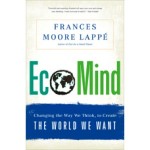 It’s always exciting to discover a strong voice in the good food movement. And it’s always humbling to realize that the voice has been loud and clear for some time, you just didn’t know about it.
It’s always exciting to discover a strong voice in the good food movement. And it’s always humbling to realize that the voice has been loud and clear for some time, you just didn’t know about it.
If you’re reading this, you have probably heard of Diet for a Small Planet, a ground-breaking book written in 1971 by Frances Moore Lappé that critiqued grain-fed meat and argued that bad food policy is the cause for food scarcity. Maybe you have a copy of this book sitting on your shelf. Maybe it turned you on to healthy eating decades ago. (I was eating hot dogs and cheese whiz in the 70s).
Two nights ago, I had the pleasure of hearing Frances Moore Lappé speak at Wychwood Barns, in Toronto, as part of a tour for her new book, EcoMind.
I’ve got to admit she left her audience feeling very inspired.
She argues that there is plenty of food in this world to go around for everyone, but scarcity exists due to our food policies, which allow for uneven and unfair food production and distribution.
Scarcity is human-made. And as the Global North grabs up chunks of Africa the size of France for farmland, it doesn’t paint a pretty picture for the future. The health hazard here is not the lack of food, it is the food supply chain.
Lappé suggests that as along as Money controls the politicians, and the politicians allow policies that help Money, the food situation will only worsen.
But Lappé gives hope – because, after all, no one wakes up in the morning anticipating wonderful ways to really screw things up for people less fortunate.
She gives concrete examples of how change is possible. From re-greening efforts in Niger that successfully created 12.5 million acres of new fertile land, to 8000 villagers in Andrah Pradesh agreeing to avoid farming with pesticides, to President Lula’s Forme Zero, in Brazil, which made food access a human right, to Wangari Maathai, who founded the Green Belt Movement in Kenya and won a Nobel Peace Prize for her work.
Lappé’s new book, EcoMind, explains how our mindset can have a lot to do with what we see as possible. If we don’t think differently, we will never solve our current crisis. From food availability to food quality, the current system does not work for 99% of the people living on this planet, nor does it work for 100% of the Earth itself.
If you care about food, read this book.
“The liberty of a democracy is not safe if the people tolerate the growth of private power to a point where it becomes stronger than their democratic state itself. That, in its essence, is fascism …”
– Franklin D. Roosevelt, addressing U.S. Congress, April 29, 1938.
A major Canadian supermarket has had to recall some of its organic baby food. The Canadian Food Inspection Agency issued a warning that some President’s Choice Organics baby food might be rancid. As a result, President’s Choice has voluntary recalled some if its PC Organic Infant Cereals.
Considering the little ones eating this food and their still developing immune systems, this is a serious concern. But parents, people – all of us – should always give food a good smell before eating it.
A woman I know in Montreal lost her sense of smell after giving birth. It was just one of those weird body-things that happen. It took years for it to return. In the meantime, her one greatest concern was not being able to smell foods before she gave it to her (by then) toddler.
Unless you’ve lost your sense of smell, check food first. Always. And especially if you didn’t make it yourself.
Food goes off. Packaging can be compromised. No one wants it, but it happens.
From the comments that follow the article that I read on CBC.ca, people are worked up and swearing off organics. In my view this is both ridiculous and reactionary.
Organic food goes off faster than processed foods precisely because it is not filled with chemical preservatives that artificially extend shelf life. If you choose to eat organic, it is likely because you want to avoid these preservatives.
We’ve become so accustomed to assuming food is always safe that we have forgotten (or are too busy, distracted, what have you) to simply use common sense.
Check the expiry dates, check the packaging, and give food a good sniff before you heat and before you eat. And let’s hope no one is seriously hurt by this.
As you may have heard, a California woman is suing the maker of Tropicana orange juice for misleading consumers that their product is “100% pure and natural” when it allegedly is not.
In her class action lawsuit, Angela Lewis said Tropicana deceives consumers by misrepresenting its Pure Premium juice in advertising and packaging.
Tropicana claims “16 fresh-picked oranges [are] squeezed into each 59oz container.” But according to Lewis, PepsiCo Inc. processes their juice extensively, and adds chemical aroma and flavours that change the juice’s “essential nature” and extend shelf life.
For its part, Tropicana has issued a statement that it “remains committed to offering great-tasting 100 percent orange juice with no added sugars or preservatives. We take the faith that consumers place in our products seriously and are committed to full compliance with labeling laws and regulations.”
Dig a bit online and you find that the packaging and advertising claims of other well known brands have also been challenged with class action suits, including Old Orchard, Welches White Grape Juice, Ben and Jerry’s All Natural Ice Cream and Quaker oats.
Now I don’t think it’s surprising that companies make claims about their products being natural, after all this is what people want. And companies are in business to give us that.
With a “premium” product, Tropicana can profit from the public’s desire for natural products, and charge a premium price.
The problem is that natural is not a regulated term like organic or certified organic. It’s the public that seems to think that natural is some kind of guarantee of quality. It is not.
Natural doesn’t mean anything in the food industry … except that we may be more likely to buy it.
It will be interesting to see what happens with this case.
Recent events in the Czech Republic, where I spent some time in the 1990s, have changed how I see the holidays this year.
In his work, the late Vaclav Havel, former Czech president, revolutionary, dissident and playwright often focused on the concept that even the powerless have power.
Havel had a gift of making lofty and seemingly difficult challenges appear simple and straightforward. He did this by appealing to our sense of decency. For example, a lone shop keeper can stand up to an entire regime he does not agree with by simply making the choice to not post a sign in his store.
I think Havel managed to make change possible because he would bring an idea down to its most basic level—big change on a small scale.
He simply asked us to live in truth.
When I think about our situation in the West regarding our mainstream food system, and its complicated relationship with industry and politics, which somehow pits yield and profit against quality, I am tempted to just bring it all down to its most basic level.
We can exercise our plea for accessible, decent, healthy food through the little choices we make every day.
We can stand up against the plethora of “edible food-like substances” that line our grocery store shelves and fill our world with advertising by simply making the choice to not buy them.
Could it be that simple?
There’s a new grocery store model under development in the U.S. If it catches on, it might just change American eating habits.
in.gredientsis slated to open in East Austin, Texas, as soon as they get their building permit approved. Co-founded by brothers Joseph, Christian, and Patrick Lane, and partner Christopher Pepe, they describe themselves as the first package-free and zero-waste grocery store in the U.S.
The concept is reassuringly simple: sell food from local vendors in bulk to customers who bring their own containers to the store. Customers will be able to buy fresh local produce in season, organic grains, spices, loose tea and coffee, dried fruits and nuts, flours, oils, dairy, local meats, local beer and wine, and household cleaners and toiletries.
Customers will bring clean containers from home, weigh and label the containers at the store, fill the container with a food item, bring it to check out, and then pay. They will also have the opportunity to allocate a portion of their purchase to a charity.
You only pay for the food you want (not the packaging, estimated to add 10-20% to your grocery bill), and for the amount your want (only need a ½ a teaspoon of sage? Not a problem). Compostable containers will also be available for purchase at the store if you don’t have any of your own.
in.gredients will be waste-free, local, and — as much as possible — organic.
The goal of this community-minded business is to reduce waste and improve the availability of healthy food in an area that is otherwise something of an urban food desert.
According to their website, single-use packaging makes up 40% of the 1.4 billion pounds of waste that are dumped in American landfills every day. Yes, that’s packaging that is used once and then tossed out.
By doing away with the packaging at the start, the group is putting the emphasis on the Reduce and Reuse in the Reduce, Reuse, Recycle mantra.
They also call it precycling.
Whatever you want to call it, less is definitely more in this case, as even recycling our current packaging requires energy and the burning of fossil fuels.
I wish these guys all the best. I hope they go far. And I hope they give other Austin-based food giants a healthy run for their money, as the more “good food” out there, the better it is for everyone. That said, education will be key in converting a customer base that is otherwise used to buying and eating processed or convenience food.
What is at stake here is not just a different shopping experience that asks you to bring your own jars and containers to the store. in.gredients is essentially asking people to purchase real food, ingredients if you will, and prepare their meals from scratch. This, in my view is the real challenge.
I look forward to hearing their success stories.
I was excited to see that a local organic meat supplier has some new nitrite-free deli items for sale. It seemed perfect: a reputable family farm that does everything right (organic and grass-fed, pasture roaming, natural breeding, etc.) comes up with carcinogen-free deli meat?
So I can have the quick easy lunch that lets me regale in the simple salami sandwich of my youth and not get cancer!
Nitrites (NO2) and their cousin nitrates (NO3) are used as a preservative in cured meats to prevent botulism. They give salami, hot dogs and bacon a longer shelf life and that reddish colour that we tend to associate with “fresh”.
The problem is that nitrates, which convert to nitrites in our digestive tract, were linked to cancer in children back in the 1980s.
Nitrites can also occur naturally in certain foods, such as celery. But for some reason, these nitrites are not found to be carcinogenic. Perhaps this is due to the detoxifying vitamin C that celery also contains.
Chatting with a chef-friend yesterday, I was assured that you cannot cure meat without nitrites. It’s “simply part of the process.” She says that if you are curing meats in your basement for family use, for example, you might get away with not using nitrites. If you get botulism, it’s your own fault. But if you’re selling the meat, and exposing yourself to potential lawsuits, you use nitrites, also called pink or curing salt.
So then how are meat suppliers making their nitrite-free meats? Apparently, many replace nitrites with celery juice or celery powered extract, which —as mentioned— contain nitrites.
Personally, I do not feel the label “nitrite-free” in this case is accurate, or perhaps even ethical. After all, nitrites are still in there. The only difference is that no one picked up a container of pink salt and poured it in. They simple added an ingredient that contains naturally-occurring nitrites. Perhaps a more honest label would be “no nitrites added”?
It remains to be seen if “nitrite-free” deli meats are less carcinogenic that regular deli meats. It is possible that the celery makes a difference.
The trick, I think, is to eat these treats in moderation. If it’s local and organic, I’m not cutting it from my diet. But I will, perhaps, make an effort to enjoy them in the traditional French charcuterie style, i.e. with a few vitamin C containing vegetables on the side.
